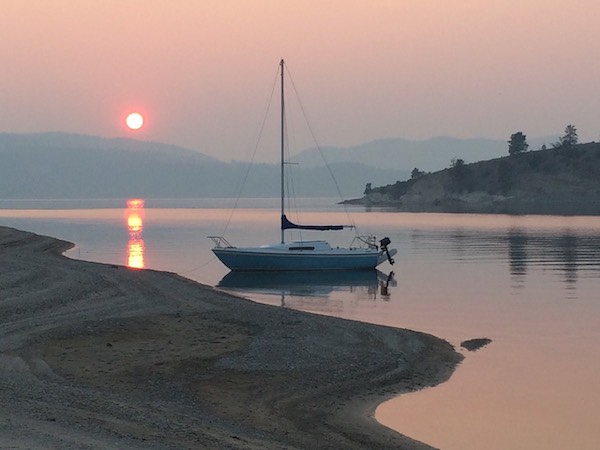Every Boat Story Is a Drama
This boat story has all the elements of a drama: high hopes, chicanery, desperation, and triumph (hopefully). This is the story of falling in love with a boat design, finding that boat in Canada, bringing it home to watch it fall apart before rebuilding it in the USA. This is the story of a boat named Mona Risa.
This initial post will try to summarize the story in one place and leave the details to other posts. But, even as I write this, the story isn’t over yet! I’m writing this in Jan 2019 while wintering in Ghana. Mona Risa is in a garage in Montana waiting to be finished. The end of this boat drama has not been written yet.
Finding the Right Boat Design
My big life goal was to retire at 45 and sail/camp for 20 years. As I wanted to cruise simply and cheaply like the Beach Cruising and Coastal Camping folks, the attributes that I felt to be important were:
- shallow draft / beachable
- comfortable motion at anchor
- able to carry a month’s worth of food
- trailerable
- possible for one person to launch and retrieve
- affordable to buy and cheap to operate
At the time, I had owned a MacGregor 22 for several years. Being a small, light weight, swing keel monohull it already met a lot of these requirements. But I didn’t consider it durable enough to stand up to full-time cruising - it was a great weekend boat. Initially I looked around at similar boats that were roomier and more seaworthy. It’s hard to find a shallow draft boat with those attributes but I fixed myself on a Pacific Seacraft Flicka 20. Unfortunately, when I looked at the used market for a Flicka I could see that the boat would fit all my criteria but the affordable one. It’s a boat that commands a premium price because of it’s great reputation.
During my search I also considered multihulls. I eventually ruled out a trimaran after finding an analysis of load carrying abilities with three hulls versus two. The two amas on a tri reduce carrying capacity because they are extra weight while providing little flotation. Whereas both hulls on a catamaran provide carrying capacity. I focused on small catamarans at this point and looked for production boats first. I found zero production boats in North America that fit my critera. However, I did run across several good designers of small catamarans for the amateur boatbuilder: James Wharram, Richard Woods, and Thomas Firth Jones.
I spent a lot of time with the Wharram Design Book and thought the Tiki boats were the most suitable for me. I ordered study plans for the Tiki 21, 26, and 30. I was very tempted by the size of the Tiki 26 cabins but I think the boat would be too much for a solo sailor to assemble at the boat ramp. So I decided on the Tiki 21. Remember, at this point I have never sailed a Wharram of any type. In fact, the only cat I had ever been on was a small beach cat in college!
Build or Buy?
Flash back to 2011 - my son, Matt, and I built a small dinghy - Super Chicken. It was a lot of fun to build together but the project was also intended to give me an idea of whether I would want to build a bigger boat. My takeaway was that building a boat was doable with my skills but it was actually cheaper to buy a boat built by someone else rather than buy the materials myself.
So in the fall of 2015 I started looking for a Tiki 21 to buy. I was not having much luck online since Wharrams are pretty rare in the Northwest US. So I was happily surprised to see a Tiki 21 in a classified ad in the back of Small Craft Advisor magazine.
I emailed and talked with Jerry, the builder and owner. The boat was in eastern Canada. He was an experienced boat builder - this was the 32nd boat he had built. And he said that we was acquainted with James Wharram and had even been asked to review the new Mana design. He sounded very experienced. And claimed to have built the boat exactly to the plans.
I researched getting a surveyor to look over the boat. I found that the nearest surveyor would charge over $400 for the survey and mileage and was not familiar with Wharram boats. It was also fall and the boat was out of the water and disassembled which would make inspection harder. So after some internal debate I decided to forgo the survey and make a deal on the boat. I paid the asking price in exchange for storage until June 2016 - I didn’t want to drive 4,000 miles in the winter to pick up the boat. The price was $4,500 CAN.
It was a long winter waiting to pick up my new boat! In the meantime, I said goodbye to Blue Mona, the Macgregor 22 I had sailed for seven seasons.

The Drama!
And this is the point in the story where the real drama begins - and keeps going for a few years!
In short, the boat was poorly built and began falling apart right away. I started rebuilding pieces and parts of the boat. But eventually decided to rebuild the entire boat as well as the trailer. So the boat that I bought at the end of 2015 did not sail in the 2016, 2017, 2018 or 2019 seasons. Frustration!
The next post will cover picking up the boat and the initial problems that occurred.